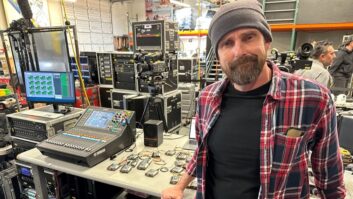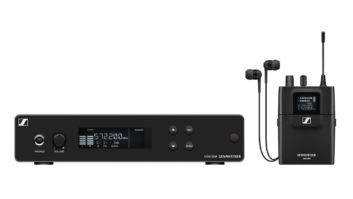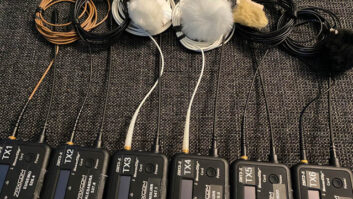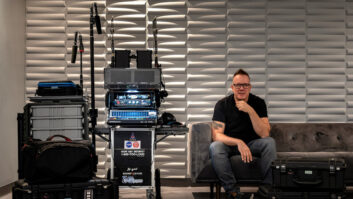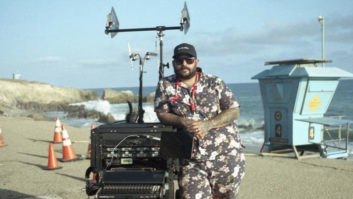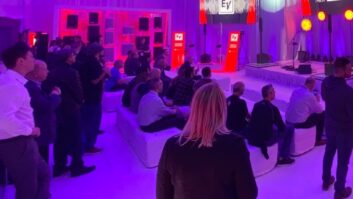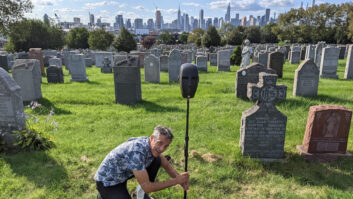Broadcasting’s current soup du jour, otherwise known as reality television, offers a plethora of nightmares to torment audio crews. Take a recent challenge posed by NBC’s Fear Factor. For some reason, contestants agreed to crawl through a rat-infested drainage tunnel while water flowed over them, in keeping with the show’s format requiring players to participate in bizarre stunts. Those logistics, in turn, required the audio crew to transmit wireless signals from contestants’ stunt mics inside the tunnel up to field mixing stations.
In the spirit of the game, the crew cheated slightly on its standard wireless approach, according to Stacy Hill, Fear Factor’s senior audio supervisor. Instead of relying on wireless mics, they planted a hard-wired mic in the tunnel that served as the equivalent of a boom.
“In the tunnel, even with high-powered wireless, our signal was extremely weak,” says Hill. “Fortunately, the video team had rigged an infrared camera on a track to follow contestants through the tunnel. We planted a Sennheiser MKH40 mic under the infrared camera as it traveled on the track, and we hard-lined that mic out of the tunnel to a wireless transmitter. That transmitter then sent a signal to the field mixer just 20 to 30 feet away so he could dial in the signal and add it to the mix. The cable was over a 100-foot run, but in the end, it became a wireless signal. In the tunnel, the mic picked up the contestants like a normal booming situation, because it was right on top of them. Of course, we also had to waterproof the mic since they poured water through the tunnel.”
Such challenges are now commonplace in the reality, or unscripted, universe. While the creative and social values of such reality-based shows can be debated endlessly, production innovations resulting from such programming are too numerous to mention. On the audio side specifically, reality-based shows have moved the art and science of wireless recording technology to a new level.
At least that’s the view of Jeff Santoro, a longtime TV and film sound mixer and owner of Pacific Technical Group, Burbank, Calif., a company that now focuses exclusively on providing equipment, crews and consultations for reality shows, including Real World, Road Rules, Fear Factor, The Mole, Murder in Small Town X and others.
“Most of these shows require a wireless approach, usually in complicated environments,” says Santoro. “When crews are following people in those environments, there are times when wireless cannot be duplicated, because, unlike other types of programming, these shows are too chaotic. Some manufacturers are now producing products specifically for this market, but crews are still innovating like crazy out in the field. That’s because, until recently, no one had approached these shows with specialized equipment or techniques, since few people really believed the trend would last. But now, there clearly is a market for this kind of specialty, so manufacturers are starting to develop new tools, or modify existing ones, for these jobs.”
MIXERS AND MICS
Production on the first season of Fear Factor earlier this year debuted one of those innovations: the Wendt X5 mobile field mixer, a tool that has since spread to several reality productions. Hill’s crew used it on Fear Factor, and programs like The Mole, Real World and Murder in Small Town X are now following suit. According to Santoro, the X5 was designed by engineer Bob Wendt in consultation with Santoro about the specific needs of reality TV audio crews.
“Before, there was no 5-input mixer you could take on location like this one, let alone a mixer you could bus together with a second one to create 10 inputs and still be mobile, so we talked to Bob and he built one,” says Santoro. “It only weighs about four pounds, with batteries, so it’s light enough to easily move as contestants move. Plus, it has features like pre-fade listen, which is crucial when you are working with wireless, as people come and go during the shoot.”
Mobile mixing boards, however, are only one part of the equation. Complicated mic choices, power issues, frequency problems, elemental hurdles and the unique requirements of individual shows also pose routine problems.
In the past year, Michael Alexander served as a principal field mixer on two new reality shows — Combat Missions and Man Hunt. He says elemental factors have “a huge impact” on audio capture for such shows in remote locations.
In Combat Missions, for instance, teams of former military and police personnel do battle using non-lethal ammunition on a mile-square chunk of the Mojave desert in Southern California. Alexander says that miking contestants for clear signals was “complicated,” mainly because of “howling wind in the desert, made worse by helicopters and other military equipment.”
“We chose to lavalier contestants with Countryman EMW mics and Sennheiser quarter-watt transmitters, but we also had to find a way to deal with the wind,” says Alexander. “We put Windjammer windscreens on them, but we needed more than that, so I asked the wardrobe guys to build burlap flap casings. They put Velcro on them, and that allowed us to enclose the microphone against the contestant. It was amazing in terms of wind reduction, and a cheap solution.”
Alexander and his colleague, Pat Sieleski, received redundant signals from contestants on Lectrosonics 210 and Sennheiser EK-4015 receivers in two separate “audio chalets” — pup tents a half-mile apart. There, they created the mix — Alexander on a Mackie 1604 board and Sieleski on a Spirit 8 Folio mixer. (Because the location was a square mile, it was split into grids, with Alexander mixing half the coverage area until contestants passed into Sieleski’s area, where she then took over.)
“Of course, being in a remote part of the Mojave desert, we first had to figure out a noise-free way to provide DC power to the mixing boards,” Alexander recalls. “Eventually, [Burbank equipment rental house] Plus 8 found us a couple of [Statpower 1000 sine wave] power inverter units, and those units ran silent unless they overheated, allowing us to produce converted DC power out of deep cell, AC marine batteries, powering the boards.”
A few months later, Alexander found himself in a similar setup on the island of Kauai in Hawaii while working UPN’s Man Hunt, in which contestants navigate rugged terrain while trying to avoid “hunters” determined to take them out of the game. On that program, contestants are given walkie-talkies to coordinate strategy with one another. That posed a problem in terms of seamlessly adding those conversations to the mix.
“I had a receiving walkie-talkie in my tent,” says Alexander. “I initially thought of just trying to record the signal by plugging into my headphones, but there was too much hum there. Instead, I gaffer-taped a Tram [TR-50] lavalier mic with a Windjammer on it to the speaker of my walkie-talkie, and ran that line directly into a Fostex PD-4 timecode DAT recorder. That gave us truer audio, the way a walkie-talkie really sounds.”
THE FREQUENCY FACTOR
Shows like Combat Missions, Fear Factor and Man Hunt all depend heavily on being able to capture clean radio signals from contestants’ transmitters. Finding the correct frequency is therefore a complicated issue. Most crews rely mainly on extensive research and tests during pre-production, but even then, complications can, and do, arise.
That’s one reason why most reality shows still rely on the venerable sit-down interview with contestants — to provide supplemental coverage in case a particular event is missed by cameras, mics or both. In addition, some wireless programs, like Fear Factor, do record some backup audio onto videotape during stunts where contestants physically carry clamshell recorders on their bodies, with tiny cameras and mics hard-wired to the recorder. Hill says those backup audio tracks were rarely needed during production of Fear Factor, however, mainly because of intense testing done with the show’s stunt team to eliminate wireless problems for each setup.
Santoro explains that, in preparation for such shows, his company spends much of its time concentrating on solving signal problems before they arise.
“Frequency coordination is the most complex part of these jobs,” Santoro says. “All the on-set frequencies alone, combined with local analog and digital TV and radio frequencies, make it difficult. Our company has developed proprietary software designed to monitor and coordinate the signals to work together as a group once we have chosen frequencies. Before that, of course, we need to use a variety of resources, such as the World Radio Handbook, and a couple Websites — particularly the FCC’s — to determine what frequencies are currently licensed and transmitting in any particular city. We generate those lists and continually compare and update them.”
Of course, not all reality shows are shot in the United States. In the original version of Discovery Channel’s Junkyard Wars, contestants are given tools, materials and 10 hours to build different types of machines from scratch that are later judged in competition against each other. The show is now produced in the United States, but Junkyard Wars began life as Scrapheap Challenge for three seasons in the UK, where its audio template was established, only to later require revision in the U.S.
Richard Meredith, co-director of England’s Total Audio Solutions, served as sound supervisor on the UK version, and as a consultant on the American version. Meredith points out that the show, like Combat Missions, has a large coverage area in both a four-acre junkyard and in different venues where the competing machines are tested. By UK law, transmitters are limited to lower power levels than in the United States. This caused Meredith to select an active antenna signal booster system from Sony to handle wireless signals in the show’s wide coverage area.
“We used the Sony WDA-820 antenna distribution system, which lets you place four antennas on a single input, and also lets you cascade the units together, creating an actual antenna network, which is more efficient for a large coverage area,” says Meredith. “Contestants wear Sony 860 transmitters, and we also put [Beyerdynamic TGX-30] headsets on them rather than lavaliers, because the contestants use tools to build their machines, and mics could be damaged or drowned out, whereas we can keep headset mics near their mouths at all times, no matter the head movement.”
The antenna network enabled Meredith’s team to send the various signals to a specially configured mobile audio truck on-site, where the signals were captured by Sony WRR-850 AC power receivers, and then added to the mix on a Sony DMX-R100 48-input studio console, and recorded out to Tascam DA-88 recorders. In order to match picture and audio, however, Meredith’s team had to create a system to transmit the signal back to the six video cameras taping the show as it was mixed.
“All the picture cutting is done in post, and the cameras are remote, so we needed to do three mixes — ‘A’ and ‘B’ mixes of the contestants, and a ‘C’ mix of the judges — and re-transmit them to the relevant cameras in the field,” he explains. “We configured the cameras with Sony WRR-855 receivers, and that captured the mixed signal and put it onto the tape with the picture, locking the two together with small Ambient Lockit signal sync units attached to each camera. The main sound in the final mix came off the DA-88 version we recorded in the truck, but this method let us match picture and sound.”
When the show moved to the U.S., however, the crew faced the opposite signal problem — American transmitters can operate at higher power levels, but with fewer frequencies per band. That created bandwidth problems in coordinating the movement of the RF signal from the contestants, to the truck and back to the cameras without interference, according to Meredith.
“I felt the original American setup had not allocated the frequencies very well,” he says. “The aim is to set up an intermodulation-free plan, whereby none of the transmit frequencies interfere with any others. The problem in the U.S. was, the bigger the ‘side bands’ become, the more they cause co-channel interference with other frequencies. In consultation with the American sound crew, we decided to swap things around so that the highest powered frequency was used for transmission back to the cameras, so most potential interference frequencies would be above everything else we were using.”
WIRELESS-LESS
Not all reality shows, of course, take place outside. Meredith also serves as sound supervisor for the Fox Family Channel recurring special The Scariest Places on Earth. That show takes place inside ancient castles around the world, where selected families are required to spend a night in total darkness while performing odd tasks.
Because the program usually is shot in old buildings with thick walls, the RF approach was not an option. Instead, audio is acquired alongside video on mini-DV recorders worn by contestants in special vests. The issue Meredith’s team faced with that approach, however, was the lack of any ability to field-mix the signal. And contestants often scream, per the format’s design, which presented a problem maintaining proper levels.
“Contestants wear Sony ECM-77 lavalier mics attached to the same little arm that holds a mini-camera, both hard-wired into the DV recorder,” says Meredith. “When the player screams, that obviously creates a high sound pressure level. We needed to keep the signal from being distorted in those situations, so we devised a little custom box specifically for this show that essentially amplifies the mic signal up, or limits it down, to the recorder’s line input level. We gave the system an amplifier, but also inserted a limiter into the box to protect against overload if voices get too loud.”
Such solutions are commonplace in the unscripted world, and future programs will feature more innovations, including the use of multitrack hard disk recorders, among other things, according to Santoro.
“In the future, many people believe that the method of acquisition for these shows in the field will be with digital Betacam and HD cameras,” says Santoro. “So many people are working right now to improve wireless technology so that the signal will interface better with Sony digital recorders, and work better around HD cameras. Right now, HD cameras bring higher-frequency noise levels with them out in the field, so problems like that need to be attacked.”
But as Santoro points out, there will never be “a correct way” to record such shows, particularly as they become more outrageous, if such a thing is possible.
“It’s a break-the-rules, make-it-up-as-you-go-along industry,” says Santoro. “That’s the biggest evolution we’re seeing — nothing ever stays the same. Every show is different and you just have to figure it out.”
Michael Goldman is the senior editor of Mix‘s sister publication, Millimeter.
